So we just rented a house in California that only has Level 1 charging (previously was in apartment complex with Level 2 charging). Since we don't own the home, we don't want to spend a big chunk of money to rewire for Level 2 charging....landlord isn't going to chip in so it'll be at our expense. The car is driven about 40 miles / day round trip, which we can recover overnight via 120v charging so there isn't a huge pressing need for Level 2 charging. Otherwise there's tons of superchargers & Level 2 chargers nearby.
With that said, I was wondering if I can take advantage of the pre-existing dryer 30 amp setup to facilitate faster charging should we buy another EV. My dad is a retired mechanic and pretty handy with electrical wiring so he can help me.
With that said, I was wondering if I can take advantage of the pre-existing dryer 30 amp setup to facilitate faster charging should we buy another EV. My dad is a retired mechanic and pretty handy with electrical wiring so he can help me.
- Panel (attached pictured) has 200 amp breaker, and panel is placed directed outside of garage
- there's a 30 amp breaker for dryer in bottom right (which isn't in in use since the existing washer/dryer is 120v with gas heating)
- laundry room is upstairs, in opposite corner far away from garage
- there's a NEMA 10-30 plug in upstairs laundry room but not possible to run wire through house due to distance



